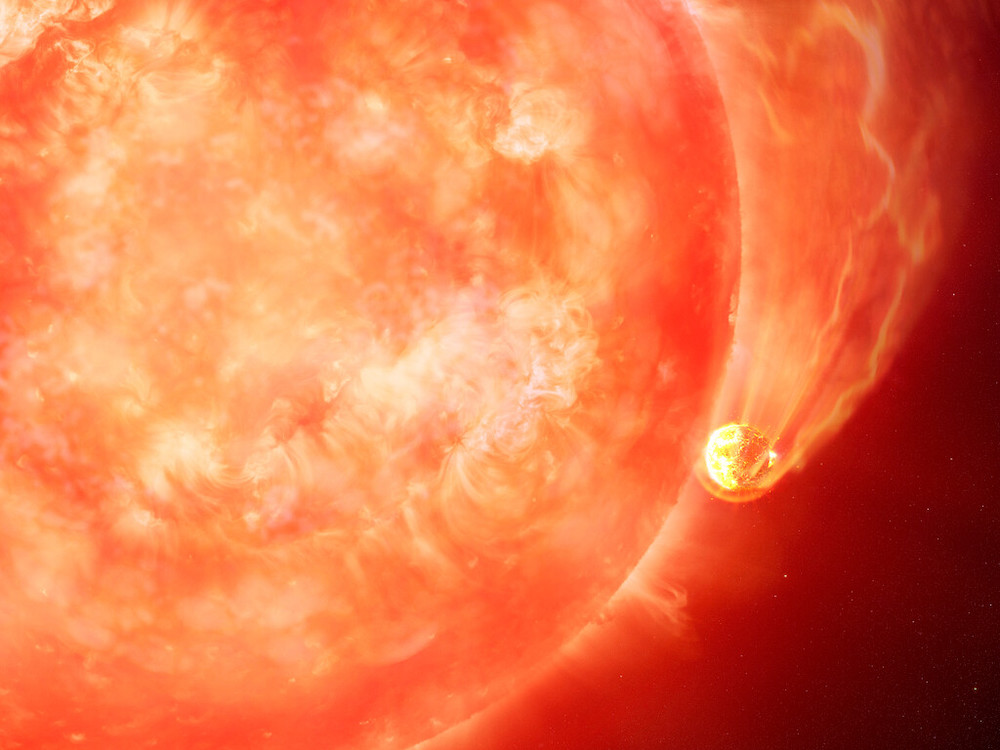Astronomers witness an exoplanet being swallowed up by a Sun-like star with a trail of long, low-energy bursts from the star. This also marks the exoplanet is sliding along the surface of the star.
” data-image-caption=”
Illustration of a star devouring one of its planets. Credit: International Gemini Observatory/NOIRLab/NSF/AURA/M. Garlick/M. age
” data-medium-file=” data-large-file=” decoding=”async” width=”1000″ height=”750″ alt=”Ilustrasi bintang saat melahap salah satu planetnya. Kredit: International Gemini Observatory/NOIRLab/NSF/AURA/M. Garlick/M. Zamani” class=”wp-image-36162″ srcset=” 1000w, 300w, 768w, 67w, 107w, 870w” sizes=”(max-width: 1000px) 100vw, 1000px” data-recalc-dims=”1″/>
Planet Eater Star
Stars evolve. And we can understand stellar evolution by studying stars at different stages of evolution. Thus we can understand the life cycle of a star as well as how the star interacts with the planets around it.
Among them is a star similar to the Sun. In a star like this, when the nuclear fusion reaction at the center of the star has turned all the hydrogen into helium, the star will enter the next stage of evolution.
At this stage, the star burns the helium in the center into carbon, and the hydrogen burning reactions actually occur in the outer layers. As a result, the star expands to 100-1000 times its initial size. And bad news for planets orbiting near stars. The expanding surface of a star can swallow planets orbiting nearby.
The interaction between the star and the swallowed planet will produce an explosion of energy and of course matter. Not only that. This process will also result in a braking of the planet’s orbital speed so that the planet finally freefalls into the star!
And this bad news is also the future life cycle of the Sun. In about 5 billion years, the Sun will also expand to become a red giant star and engulf Mercury, Venus and Earth.
Sun-like star events swallowing planets are not uncommon. Astronomers predict that in at least one year, there will be several Sun-like star-devouring planets in the Milky Way. Observational evidence of this event also exists. However, these observations are in the form of traces left after the planet was swallowed up by the star.
This time, the astronomers actually caught a star eating planets!
” data-image-caption=”
Infographic of the evolution of a star that ends up swallowing a nearby planet. Credit: International Gemini Observatory/NOIRLab/NSF/AURA/P. Marenfeld
” data-medium-file=” data-large-file=” decoding=”async” loading=”lazy” width=”1000″ height=”563″ alt=”Infographic of the evolution of a star that ends up swallowing a nearby planet. Credit: International Gemini Observatory/NOIRLab/NSF/AURA/P. Marenfeld” class=”wp-image-36164″ srcset=” 1000w, 300w, 768w, 89w, 142w, 870w” sizes=”(max-width: 1000px) 100vw, 1000px” data-recalc-dims=”1″/ >
Planet Eater Star
The expanding star devours a nearby planet and astronomers watch it in a long, low-energy burst. This explosion was found on one of the stars in the Milky Way which is 13,000 light years away.
The question is, how to distinguish the explosion of a planet swallowed by a star from other types of explosions on stars such as star flares and coronal mass ejections?
To distinguish these explosions requires high-resolution observations to determine the location of explosions or bursts as well as measurements of long-term brightness without being affected by nearby stars.
This data was successfully obtained by the Gemini South Telescope.
In data from the Gemini South telescope, the explosion when the star devours the planet lasts 100 days. In addition, the characteristics of the light curve and the material ejected during the explosion are important information to determine the mass of the stars and planets they swallow.
This explosion ejected material consisting of 33 Earth masses of hydrogen and 0.33 Earth masses of dust. From the results of the analysis, astronomers estimate that the initial mass of the expanding star is between 0.8-1.5 solar masses and the mass-devoured planet is between 1-10 Jupiter masses.
Meanwhile, material ejected from the explosion when a star devours a planet can become a recycled material that enriches the interstellar medium.
Observation
This event of a red giant star devouring one of its planets was observed by the Gemini South Adaptive Optics Imager (GSAOI) attached to the Gemini South Telescope. But the first evidence of this event actually comes from the image of the Zwicky Transient Facility. In addition, confirmation of this event was also obtained from the Infrared Observation Archive of the Near-Earth Object Wide-field Infrared Survey Explorer (NEOWISE). This event is known as ZTF SLRN-2020.
In the future, the Vera C. Rubin telescope could take part in observing the chemical pollution effects of stellar debris when it appears elsewhere and is a sign of planet-swallowing events. What is certain is that by understanding the event of a star swallowing a planet, we can understand the evolution and end of the planetary system, including what will happen later in the Solar System.
Related
2023-05-03 15:03:04
#Fate #Planets #Sunlike #Star #Systems


